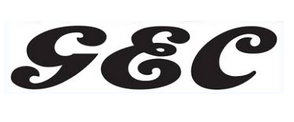
The General Electric Company Limited of England (no connection with General Electric in the USA) was perhaps the greatest of those classic British electrical manufacturing companies that made everything from heavy plant down to miniature components. The long and complex evolution of the company is documented in several sites on the Web, from its pre-history in the 1880's to its near-collapse and renaming as Marconi Corporation in 2004, and its final purchase by Ericsson in 2005.
In the 1950's and 1960's GEC played a major role in British semiconductor research and development, which was not far behind the Americans. However, information about this period of their industrial history is scarce. As with Mullard, much more is published about GEC's valves/tubes than about their transistors. The most informative source that I have found is a book in Google Book Search, 'The GEC Research Laboratories, 1919-1984' by Robert Clayton and Joan Algar. This explains that their research laboratory was based in Wembley, North London, and after an initial period, their germanium transistor manufacturing plant was established in Hazel Grove (Stockport) in 1956. In 1961, GEC Semiconductor merged with its main competitor in the UK, Mullard/Philips Ltd., to form a joint venture called Associated Semiconductor Manufacturers (ASM). Devices were marketed through Mullard, and so GEC devices can be found bearing the Mullard name, examples can be seen below. This happened just as silicon transistors were beginning to be commercially available, so very few of these were branded as GEC devices. ASM lasted until 1967 when GEC sold its interest to Mullard Ltd.
GEC's main semiconductor product lines were the GET series of germanium transistors and the GEX and SX series of germanium and silicon diodes. Their experimental types and development samples used the prefix EW, which stands for 'experimental Wembley'. These are particularly interesting and desirable to me. Their devices usually bear the GEC logo, the type number in capitals e.g. GET103, and often the two-letter date code employed by the UK military CV series.
GEC were active in the early development of transistor radios. They first published a circuit in 1951, using five point-contact transistors. A slightly more practical set of circuits was published in 1954, again using point-contact transistors. One of these historic radios has been reconstructed by a correspondent, Henry Irwin. To my knowledge, this is the only working point-contact transistor radio in the world.
I do not possess all the transistors below, in fact I am seeking examples and data for many of them. It is noted in the text where I am seeking examples of any particular type: if you have some for sale or exchange, please Conversely, I am happy to help anyone looking for information on these devices. I have an extensive collection of original data sheets and books, and can provide characteristic data on most of the series shown below.
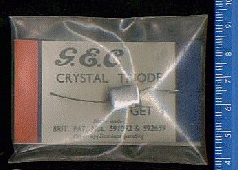
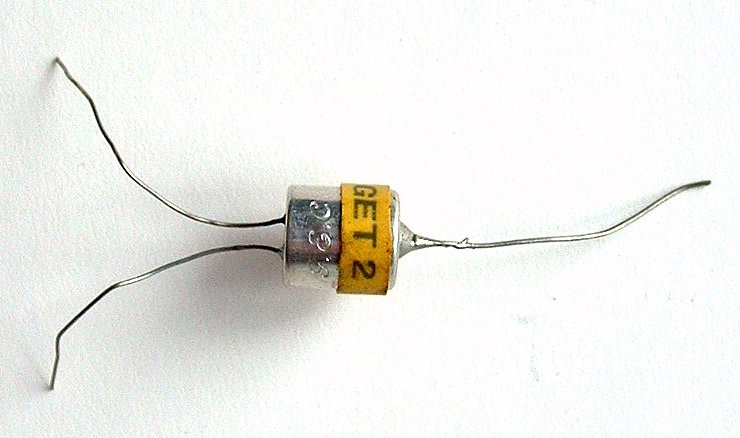
The first transistors made by GEC were the GET1 and GET2 point-contact switching types, for which I have data sheets dated 1953 and 1954, although GEC certainly had experimental versions several years before that. These transistors are characteristic of early point-contact types in that the base lead emerges from the opposite end of the cylindrical body from the emitter and collector. This is because the base wire is attached to one side of the germanium die, and the collector and emitter point-contacts press upon the opposite side. Both types use a squat cylindrical aluminium cylinder with what looks like rubber end caps through which the wires emerge. Early versions have the GEC logo and the part number engraved in the metal; later examples have a shrink-fit yellow plastic band with that infomation printed upon it. Specimens in original condition come in a small sealed polyethylene packet containing a printed card bearing the words 'CRYSTAL TRIODE' and various details.
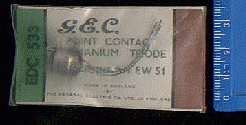
The above two GET types were the only point-contact transistors sold commercially by GEC, although I doubt that they were ever offered to anyone other than government research institutions like Harwell Laboratory. However, a small number of point-contact transistors in the EW experimental series are mentioned in the literature. One is the EW51, another switching transistor. I have some examples in original packets as shown, which contain a card printed 'POINT CONTACT GERMANIUM TRIODE'. I have another loose with its card, which is printed 'CRYSTAL VALVE' and has the part number crudely rubber-stamped on it.
I am seeking examples of any EW series device. I also wish to buy original data sheets for any of these devices. If you know where I might find some, please
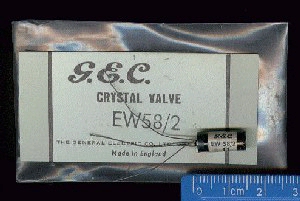
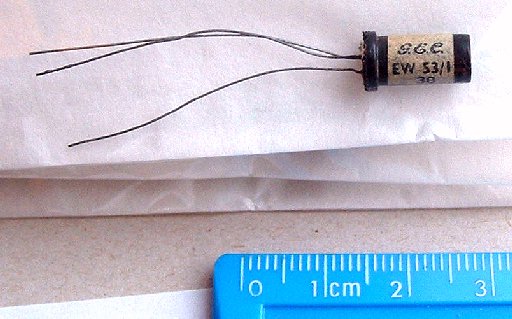
In 1955 GEC announced its first junction transistors, EW53 and EW58, in a copper can with a black plastic surface and a small paper label fixed on it. Both come in two versions distinguished by a suffix of either /1 or /2. My images show EW53/1 and EW58/2. All are germanium low-power AF types. This is the last usage of the term 'CRYSTAL VALVE'.
There is also a similar type EW59 which I am keen to acquire. If you know where I might find some, please
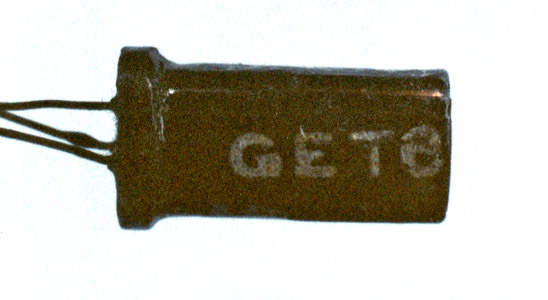
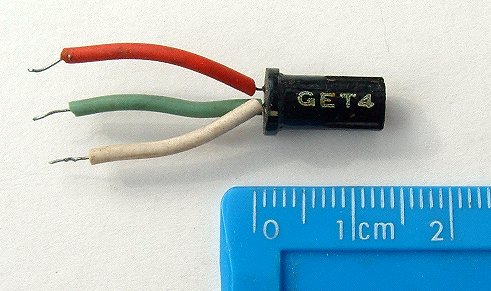
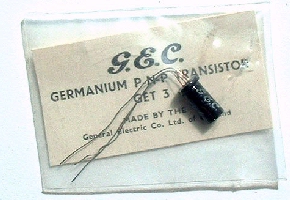
In 1956 GEC announced the GET3, GET4 and GET6, all germanium PNP low-power types that are presumably production versions of the EW53 and EW58 devices. However, some used this unusual crudely black-painted can with three longitudinal grooves in it. By this time GEC was using the term 'transistor'.
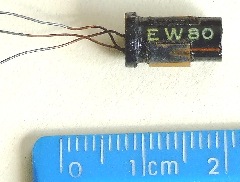
I was able to buy some EW80 devices (now out-of-stock) from the amazing vintage-parts.com Web site They have no data on these but my research reveals that in April 1958 the UK magazine 'Wireless World' mentioned them briefly as 'effectively a high-voltage version of type GET4'.
I am seeking original data on this type. If you know where I can find it, please
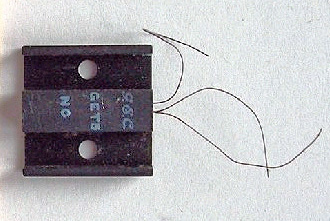
Also in 1956, GEC announced the GET5, a medium-power AF type. This seems to have used the same outline as the GET3, GET4 and GET6, but presumably unpainted, and fitted into a 1-inch square black painted copper heatsink, perhaps using the grooves mentioned above to locate it. GEC made a good number of types in this outline, which is one of my all-time favourite transistor shapes. The date code NC on this example stands for March 1957.
I am very keen to find examples of the type GET10, which had the same size and shape, if you know where I can find any, please
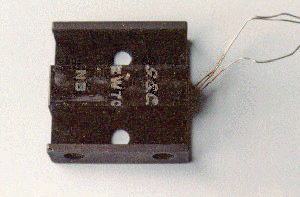
Again there was a prototype device, the EW70, although the only reference to it that I have found is in Wireless World in February 1957. I know from an image in that magazine that the first examples had a more primitive heatsink made from bent sheet metal. Some of the GET5's may also have had this form.
I am seeking original data on EW70, and examples of any GEC device with such a primitive heatsink. If you know where I can find any, please
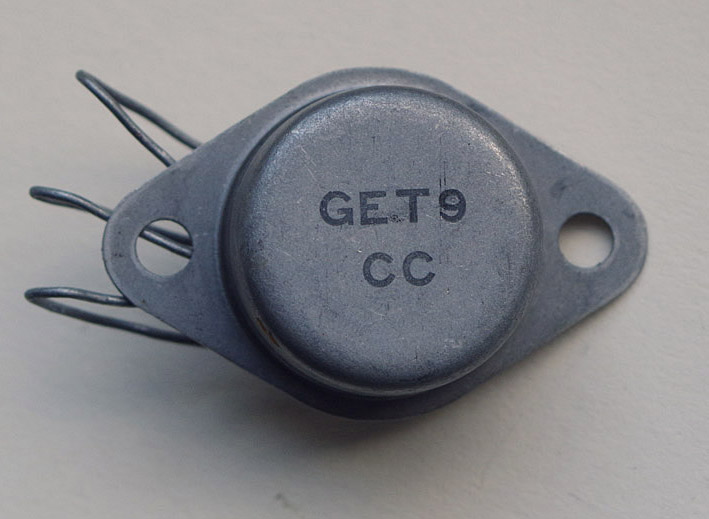
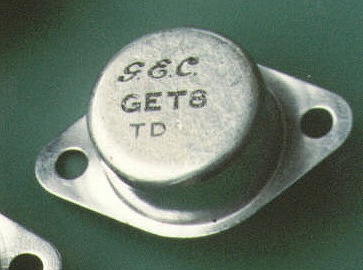
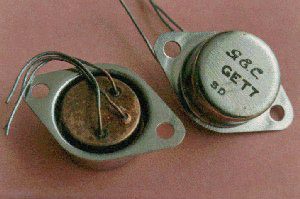
In 1957 GEC produced their first true AF power transistors, the GET7 to GET9, in an outline that looks like a protype TO-3, but taller with three leads rather than two pins, and without the solid base plate. These types were released about a year after Mullard had issued their first power AF device, the OC16. According to the book mentioned above, these are commercial versions of the experimental type EW57. This seems to have been a generic designation for power transistor development.
I am seeking examples of the GET9 with the GEC logo. My example is unusual in not bearing this, and also in having the anomalous code CC that cannot be a CV-style date code. It is also a dull grey rather than being shiny metal. I have seen similar examples of GET7 and GET8 and I would be very interested to understand these differences. A copy of 'MOD acronyms and abbreviations', found on the Web, has a number of entries for CC but the only plausible one is 'Coastal Command', a branch of the RAF that existed from 1936 until 1969.
I also wish to buy original data sheets for all three devices and I would be extremely interested in any EW57 examples that may exist. If you know where I can find any of these things, please

There is also a rare type GET10 in the 1-inch black heatsink outline. I would be extremely interested in examples of it. If you know where I can find any, please
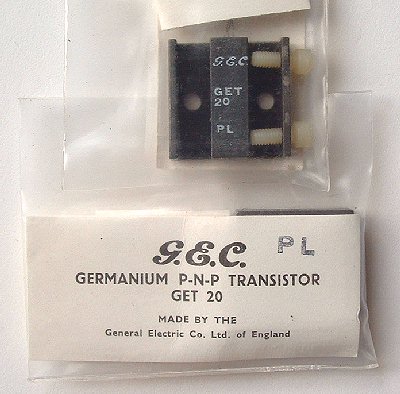
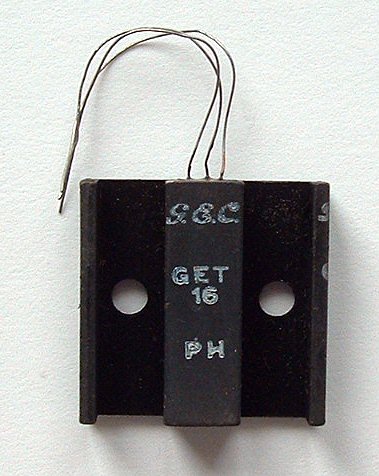
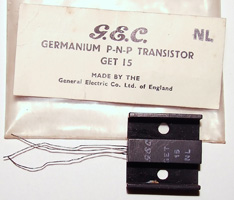
There are three more low-numbered types: GET15, GET16 and GET20, all medium-power types in the outline with the black square heatsink. The date GET15 code NL stands for November 1957.
I have a data sheet dated October 1958, called 'Transistor Terminal Connections Issue 1', in which GEC states that 'in order to comply with the general practice for lead orientation', they are going to adopt a new order for the leads on their transistors. The older types of transistors 'are now replaced by equivalents ... and are distinguished by adding 100 to the original type number. Transistors thus modified are the GET3, GET4, GET5, GET6, GET10, GET15, GET16 and GET20'. Oddly, this is the only printed reference to GET10 that I have found.
The sections below are based on the booklet 'GEC Semiconductors Device Guide' dated January 1962, although I describe transistors before diodes unlike the Guide. Note that many of these devices date from before 1962, and I have older data sheets for a good number of them.
The first category of transistor in the 1962 Device Guide is 'Germanium p-n-p A.F. Transistors', which comprises two groups:
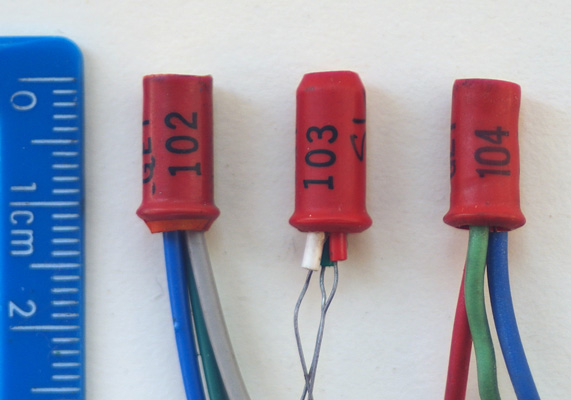
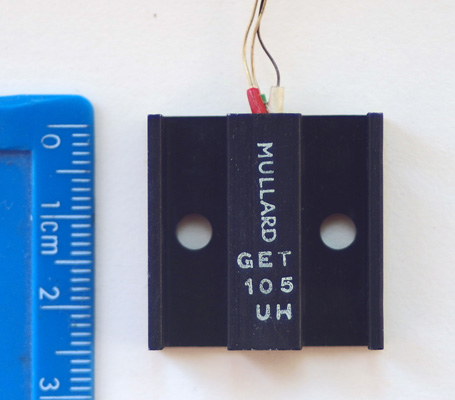
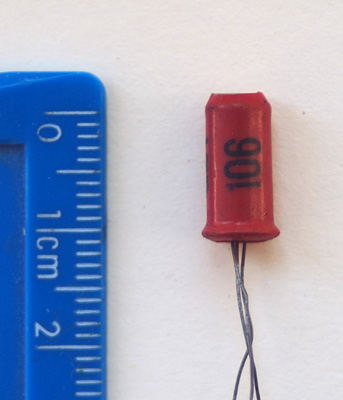
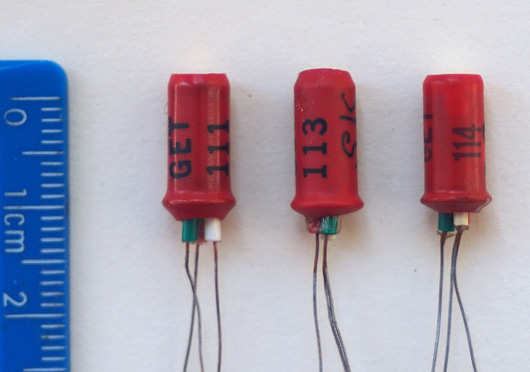
However, I am aware of the existence of types GET118 and GET119 that do not appear in any GEC publication. The only examples that I have seen are branded Mullard, suggesting that they are later than 1961. I would be interested in data on this type.
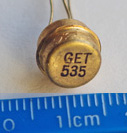
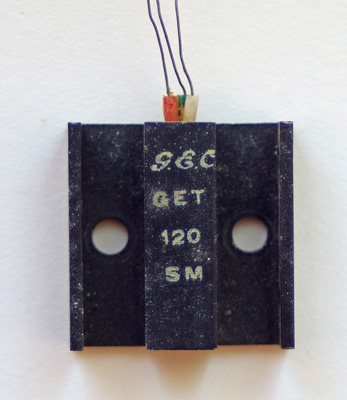
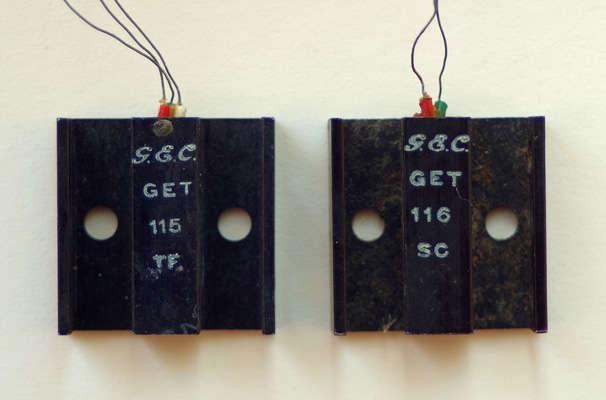
The next category of transistor in the 1962 Device Guide is 'Germanium p-n-p Medium Power A.F. Transistors', which comprises three devices:
These are the same as GET15, GET16 and GET20 but with the leads re-ordered. They have a Ptot in free air of 440mW rising to 800mW on a 3inch square heatsink.
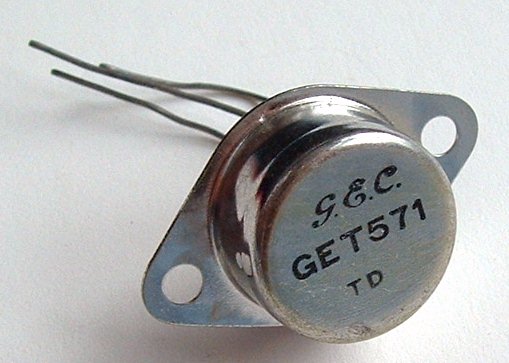
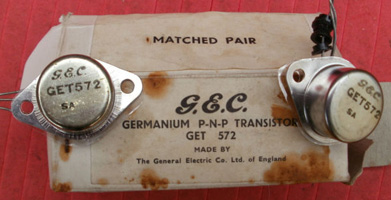
The third category of transistor in the 1962 Device Guide is 'Germanium p-n-p Power Transistors', which comprise three devices:
These have the GEC 'prototype TO-3' outline as first used by the GET7 to GET9. No Ptot is given, instead a maximum collector current of 12 Amps is specified.
Next in the 1962 Device Guide is 'Germanium p-n-p R.F. Transistors', which comprise two large groups:
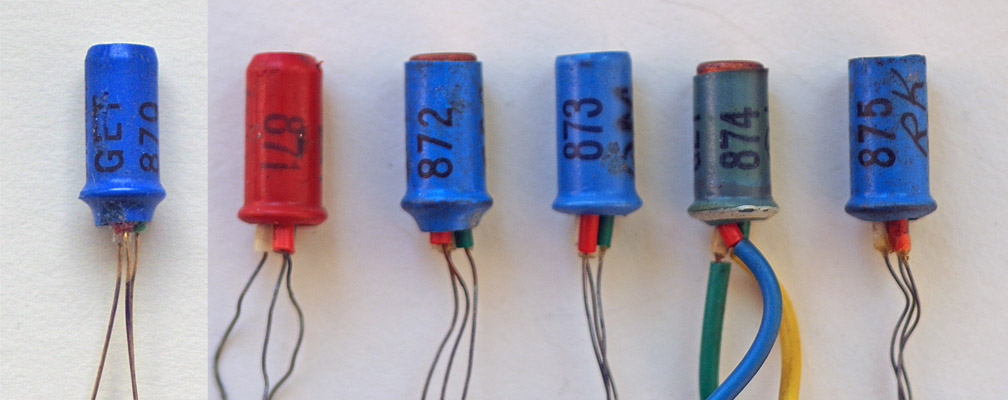
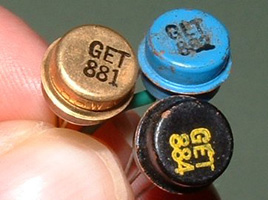
There are more devices in the GET89x range: GET895 to GET898 of which I have a Mullard GET897. I suspect that these were post-ASM and therefore not branded GEC.
There is also a Mullard germanium type GET931. This is listed in the D.A.T.A Book of Discontinued Transistors, 1969. I would be interested in obtaining an example of it.
There are also silicon GET types made by the General Electric Co. of the USA. Confusingly they made a few low-numbered ones: GET914, GET929 and GET930. These have nothing at all to do with the UK company.
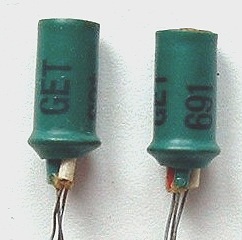
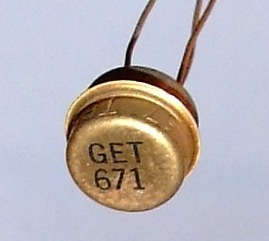
The GET691 to GET693 types, in a green sleeve, formed a short-lived series of germanium PNP IF types from about 1960. The device guide calls them 'Germanium p-n-p HF Transistors' and says that they have been replaced by similar types in more modern TO5-type outline, the GET671 to GET673, which were only available as 'radio package types'.
I am seeking examples of GET693, GET672 and GET673 transistors. If you know where I can find any of these things, please

Next in the guide is a section on 'Germanium p-n-p Mesa Switching Transistors' containing the types 2N705, 2N710 and 2N711. I have never seen any examples of these made by GEC, although they are common from other (mainly US) manufacturers.
I am seeking examples of these or any 2N series transistors branded GEC (not GE of the USA!). If you know where I can find any please
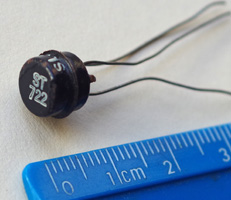
The guide then has a section on 'Silicon n-p-n R.F. Transistors' containing the types ST721 to ST723 in the 'prototype TO-5' outline. One may conclude that these are GEC's first and only commercial silicon transistors, because the creation of ASM seems to have resulted in the cessation of GEC branding. The image shows a black-painted ST722.
I am seeking examples of all the ST types. If you know where I can find any please
GEC made diodes of different types in several series, considerably more series than transistors, but before showing these in the order shown in the 1962 Guide, here is a series of transistors that puzzle me.

This GEC S1 transistor, and similar S3, S5, S6 and S7 in my possession, are devices for which I have no data. I also have a few S1 in the original black-painted can used by the earliest GEC junction types, such as GET3 above. One might guess that the part number suggests that these are GEC silicon transistors, but measurements show that is not so: they are germanium.
I have learned that two S1s were used as output transistors in the Baird Wondergram miniature record player (sold in the USA under Emerson) from 1960. The transistors can be seen clearly on this Russian site and the schematic is available on the Radiomuseum site. Oddly, 'RF' is printed on the transistors and shown on the schematic, although they are used as AF types in the circuit. This could be because the schematic may have been reverse-engineered from the actual circuit, and RF is the date code for June 1960.
I am seeking examples of S2 and S4 transistors. I also wish to buy original data sheets for any of these devices. If you know where I can find any of these things, please
Now I turn to GEC diodes of different types, but before looking at various groups ordered according to the 1962 Guide, there are some earlier glass-bodied point-contact types that it omits, suggesting that they were already obsolete. The following are listed in a small booklet called 'GEC Germanium Crystal Rectifiers' and dated February 1951. It does not give any details of function for each type, but shows circuits of:
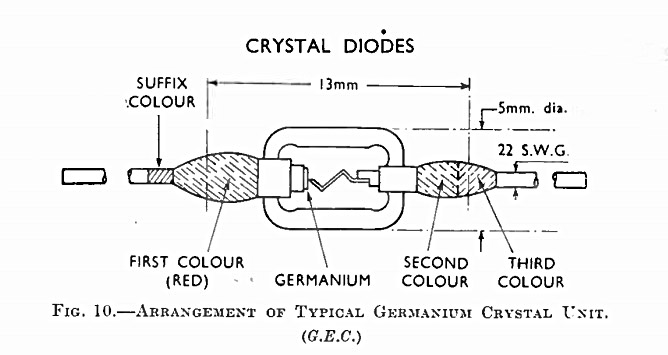
The diodes are identified by paint stripes on the wires in the electronic colour code as shown in this diagram from a 1954 book. The part number is encoded by two colours at the anode end, the cathode having a red paint stripe. There is also possibly a suffix number encoded on the cathode end, which may be an addition made between 1951 and 1954.
Unusually, the 1951 booklet includes prices (in pre-decimal shillings and pence).
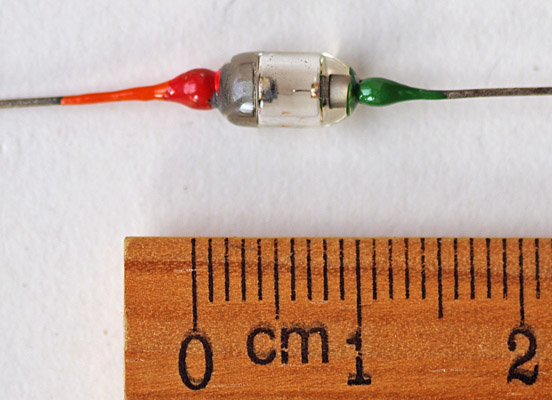
These appear to differ only in reverse current at 10 volts: from <1000 µA for the cheapest (GEX33) to <10 µA for the GEX55. The image shows a GEX55, but it came with a GEC label printed GEX55/3, and it does have an orange stripe beside the red paint on the cathode. I have seen no data for such a qualifier. I would be very interested in examples of any such diode with only coloured stripes.
I have various other GEC booklets that expand the series:
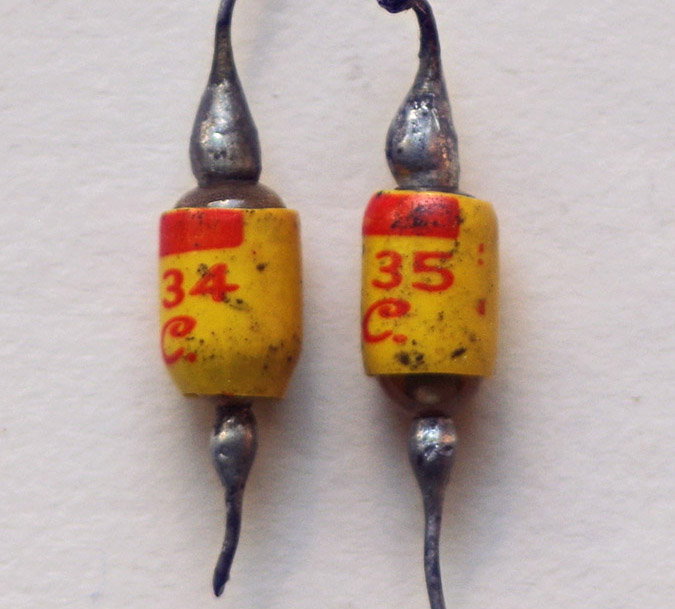
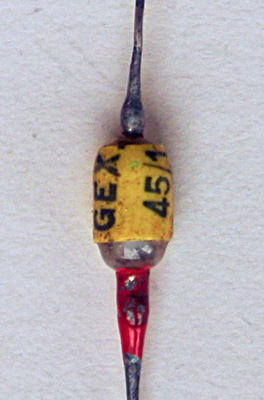
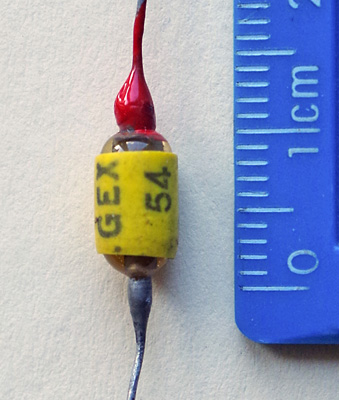
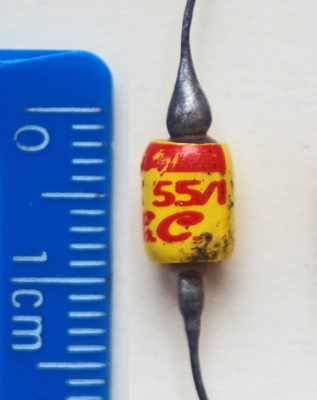
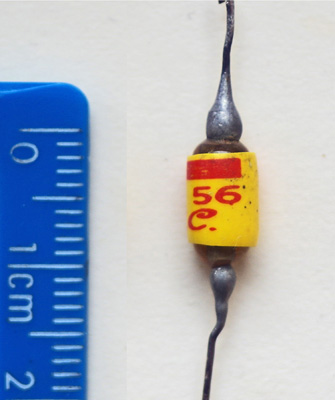
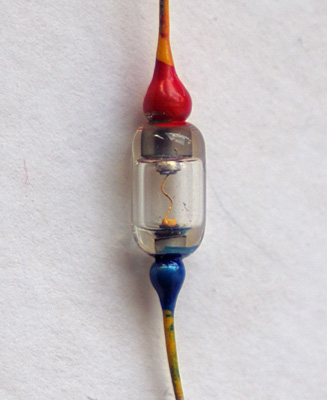
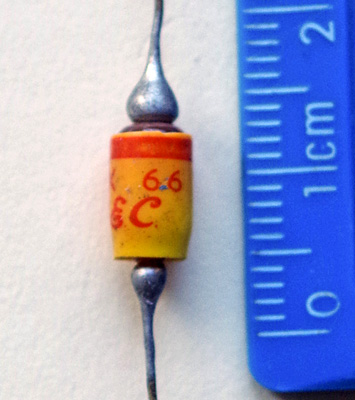
The images show those I have managed to find, most in plastic sleeves, but sometimes these can be found only identified by paint stripes on the anode wire like the earlier types. The GEX64 shown is one such, it's not very clear but it has blue and yellow stripes, and the cathode has yellow (possibly orange, it's hard to tell) as well as red, so it must be GEX64/4, although I have seen no data for such a qualifier. Oddly, there is also yellow paint on the spring 'point contact' that presses against the germanium die.
I am seeking the ones I need to complete the set:
and also a GEX64 with a printed sleeve.
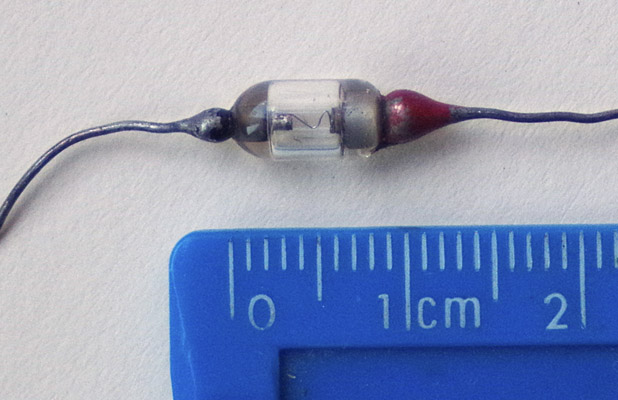
Information on radiomuseum and elsewhere reveals the existence of a type GEX00 described as 'TV detector suitable for inputs up to 5V rms. Similar to the GEX35 with a slightly lower efficiency'. This may well have been a way for GEC to sell slightly out-of-spec devices. It is identified by a wide black paint stripe (two stripes merged in fact) on the anode end. Radiomuseum states that there is a GEC data sheet dated April 1952, but I do not possess this. My image shows what I believe to be a GEX00, although most of the black paint has come off. I am seeking a copy of that data sheet (original or scanned).
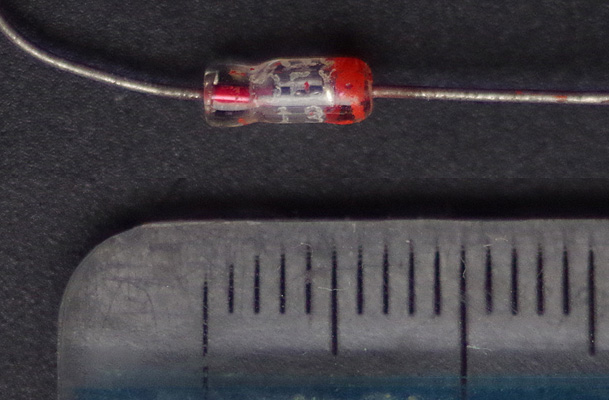
Returning to the 1962 Guide, it starts with 'Subminiature Germanium Point-Contact Diodes' containing the types GEX11, GEX13, GEX23 and GEX24. These had different applications, but all of them are shown as being replaced by 'standard diodes', also in the GEX series. The text also states that GEX66, a very high-speed switching diode, remains available, but this seems to be an error and the correct type is GEX71.
My image shows a GEX13. It is unpainted and has GEX 13 printed on it in white, plus the GEC logo. The scale is in mm.
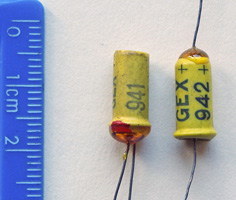
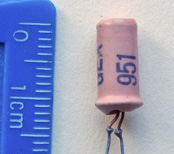
Next are 'Germanium Gold-Bonded Diodes' in three groups:
I am seeking examples of GEX952 and GEC-branded GEX71.

Next are 'Mixer Diodes', rather a motley section:
I do not have any of the SIM or GEM types. I have examples of GEX64 with suffixes that the Guide does not describe: GEX64/4 and GEX64/5.
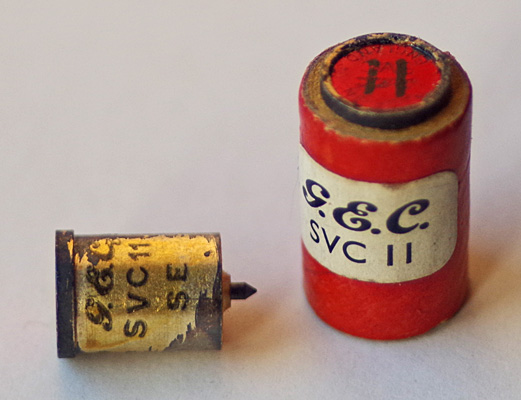
Next follows 'Parametric Amplifier Diodes', an obscure type of device. They are silicon variable capacitance diodes, better known as 'varicap or varactor' diodes. The booklet shows three series: SVC11 to SVC17, SVC21 to SVC22, and SVC31 to SVC37. The only type I have is this beautiful SVC11. It has a gold-plated squat brass body about ½ inch long with a sharp pin at one end. The other end is painted red, stamped GEC SVC MADE IN ENGLAND and handwritten 11. It is stored in a short cardboard tube labelled with the GEC logo and the part number. The date code SE, assuming it follows the standard CV series format, stands for May 1961. I think it is beautiful and I would welcome examples of others in the three series.
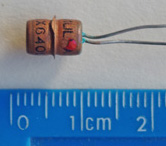
The varicap section is followed by another odd one: 'Non-linear Diodes'. Four devices are listed: SX640, SX630, SXL63 and GEX540. Following the usual convention the first three are silicon, the last germanium. All are junction types. Oddly, these can be found in other GEC publications without being identified as non-linear. I only possess the one SX640 shown, and it is branded Mullard, so I'm looking for GEC examples of all of these.
This small copper canister with a central flange joint was used by GEC for most of their low-power silicon diodes. Early examples have a slightly narrower body and a relatively larger diameter flange. The GEC logo is printed on it, and the part number is normally followed by a date code in CV series format.
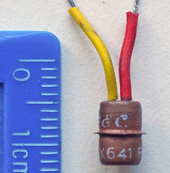
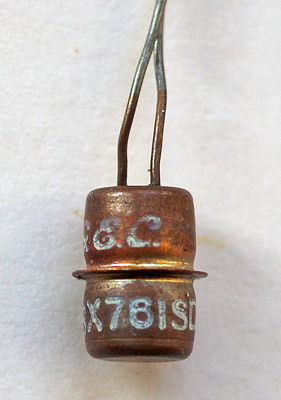
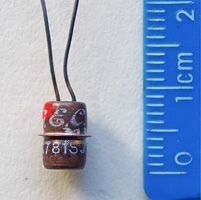
After those oddities we come to more conventional types, starting with 'Silicon Junction Diodes'. However, this section is rather varied, as it contains several groups of devices:

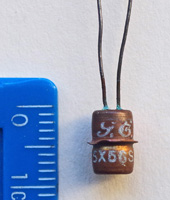
Next are 'Silicon Zener Diodes' comprising four groups of devices:
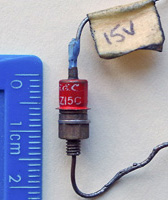
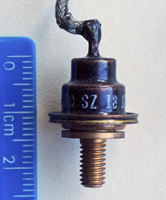
The suffix B high-power types also come with a further suffix letter N that denotes reversed ('negative') polarity.
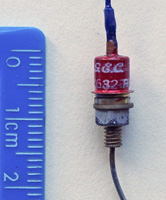
Then follow 'Medium Power Silicon Junction Rectifiers' comprising the series SX631 to SX638 with max piv varying from 100V to 800V and a max current of 0.75 Amps for SX631 to SX634 and 0.5 Amps for SX635 to SX638. SX632 is shown.
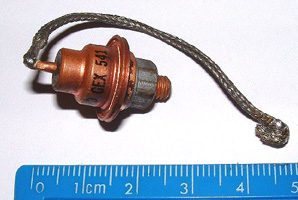
After that are 'Medium Power Germanium Junction Rectifiers' comprising two devices: GEX541 and GEX542 with piv values of 80v and 160V and capable of up to 6 Amps with suitable heatsink. The image shows an unused GEX541 with its braided anode lead.

As well as individual devices, these were sold in 'stacks' comprising multiple diodes in a specific configuration, for example a three-phase bridge. I have an original data sheet entitled 'GEX541 Stacks' that lists about 200 different configurations! The image shows a stack handwritten as type D4P1, which is not listed on the datasheet although a finned version D4P1F is. I believe that the blue paint is an insulator.
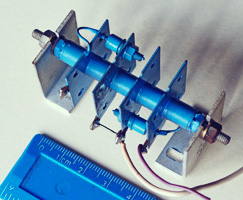
Interestingly, I have acquired this assembly that looks like a similar stack but using lower-current diodes. It seems to be a similar blue colour, and has handpainted on one end fin 'V1P1' (possibly 'N1P1') 'SX631' and on the other end fin 'SF'. Such stacks are not mentioned in my data books, but the use of only two diodes seems unusual in a power supply, unless a centre-tapped transformer was used.
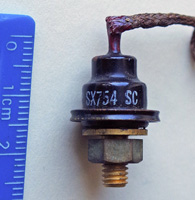
Then 'Silicon Power Rectifiers' comprising four devices, each with two polarity versions: SX751 and SX751R, SX752 and SX752R, SX753 and SX753R,and SX754 and SX754R. Their piv values vary from 100V to 400V and maximum current is 8 Amps with a suitable heatsink. The R suffix denotes 'reversed' polarity. The image is of SX754 (date coded SC for March 1961).

These too were available in various stacks : here is a full bridge stack of four SX754.
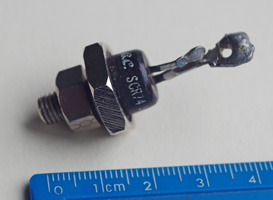
And finally 'Silicon Controlled Rectifiers' i.e. three-terminal thyristors, not simple diodes, comprising four groups of devices with different thermal resistances and associated different maximum currents:
The latter two groups are rather large devices to support those impressive currents. I'm unsure how commercially successful they were : examples of them are rare nowadays. I only have the SCR74 type shown. I would like to find examples of the rather large SCR9x and SCR11x types.
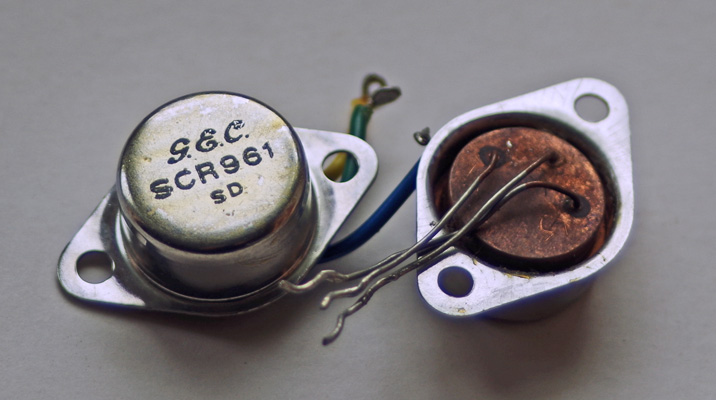
I have come across this unusual device: it is in the old bespoke outline that GEC's oldest power transistors use, but it is marked SCR961. The date code SD is for December 1960. I have found data for it in the D.A.T.A. book 'Semiconductor Diode & Rectifier Characteristics Tabulation 1961 vol VII', 1961. This reveals that it is indeed a thyristor, and that GEC made SCR961 to SCR968, presumably all in this outline. If you have examples of, or original GEC data for, any of these please
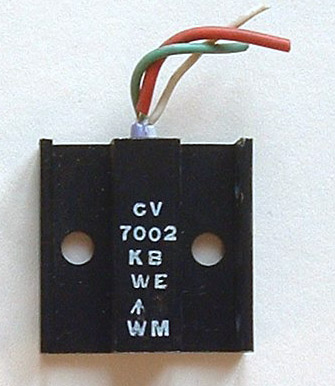
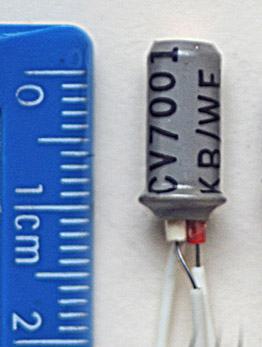
Like most UK semiconductor manufacturers, GEC made CV equivalents of their devices. These are military-grade versions of commercial types, given a Common Valve type designation. There is a large number of such CV equivalents of GEC transistors and semiconductor diodes, nearly all bearing the factory code WE for Hazel Grove. The images show CV7001 which is equivalent to GET103 and CV7002 which is equivalent to GET116.
I am interested in obtaining examples of the following CV types from the 1963 CV Register:
| CV166 = GEX54/3 | CV2154 = SIM2 | CV2155 = SIM5 | CV5104 = GEX541 | CV5145 = GEX45/1 | CV5318 = SVC11-15 |
| CV5411 = 2-GET110 | CV5656 = GEX64/4 | CV5833 = GET875 | CV5851 = GET573 | CV5856 = GET110 | CV5902 = GET104 |
| CV7007(GEC version only) = GET111 | CV7081 = GET572 | CV7088 = SVC1 | CV7130(GEC version only) = GEX23 | CV7326 = GET111 | CV7327 = GET102 |
| CV7369 = GEX23 | CV7392 = GET116 | CV8104 = SZT2 | CV8111(GEC version only) = GET105 | CV8150 = GET880 | CV8362 = GET103 |
| CV8363 = GET102 | CV8366 = GET573 | CV8607 = GET113 | CV8618 = GET885 | CV8641 = GET890 | CV8642 = GET887 |
| CV9039 = GET882 | CV9069 = GET881 | CV9070 = GET889 | CV9071 = GET892 | CV9258 = 2-GET103 | CV9266 = GET538 |
| CV9267 = GET888 | CV10376 = GET880 |